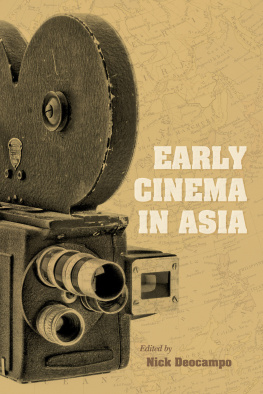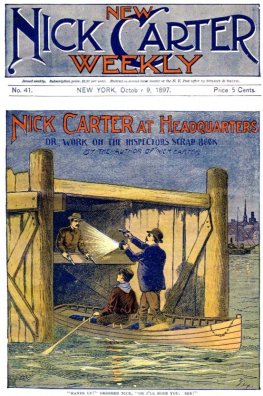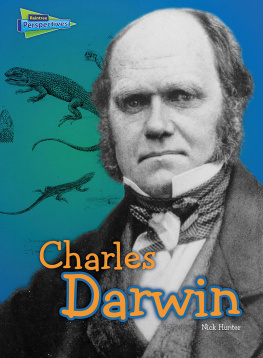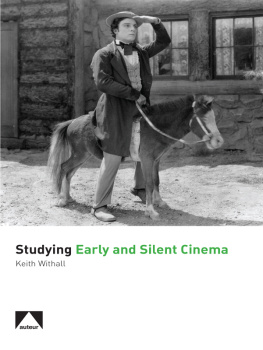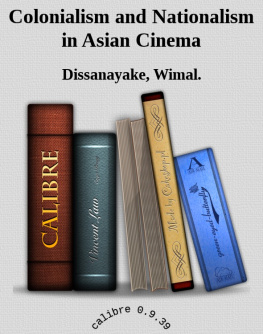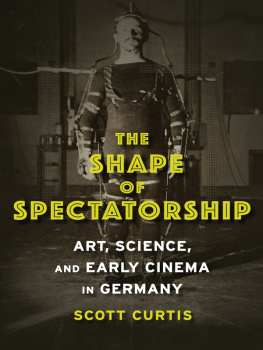Nick Deocampo - Early Cinema in Asia
Here you can read online Nick Deocampo - Early Cinema in Asia full text of the book (entire story) in english for free. Download pdf and epub, get meaning, cover and reviews about this ebook. year: 2018, publisher: Indiana University Press, genre: Politics. Description of the work, (preface) as well as reviews are available. Best literature library LitArk.com created for fans of good reading and offers a wide selection of genres:
Romance novel
Science fiction
Adventure
Detective
Science
History
Home and family
Prose
Art
Politics
Computer
Non-fiction
Religion
Business
Children
Humor
Choose a favorite category and find really read worthwhile books. Enjoy immersion in the world of imagination, feel the emotions of the characters or learn something new for yourself, make an fascinating discovery.
- Book:Early Cinema in Asia
- Author:
- Publisher:Indiana University Press
- Genre:
- Year:2018
- Rating:4 / 5
- Favourites:Add to favourites
- Your mark:
- 80
- 1
- 2
- 3
- 4
- 5
Early Cinema in Asia: summary, description and annotation
We offer to read an annotation, description, summary or preface (depends on what the author of the book "Early Cinema in Asia" wrote himself). If you haven't found the necessary information about the book — write in the comments, we will try to find it.
Early Cinema in Asia — read online for free the complete book (whole text) full work
Below is the text of the book, divided by pages. System saving the place of the last page read, allows you to conveniently read the book "Early Cinema in Asia" online for free, without having to search again every time where you left off. Put a bookmark, and you can go to the page where you finished reading at any time.
Font size:
Interval:
Bookmark:

EARLY CINEMA IN ASIA
EARLY CINEMA IN ASIA
Edited by Nick Deocampo
Indiana University Press
This book is a publication of
Indiana University Press
Office of Scholarly Publishing
Herman B Wells Library 350
1320 East 10th Street
Bloomington, Indiana 47405 USA
iupress.indiana.edu
2017 by Indiana University Press
All rights reserved
No part of this book may be reproduced or utilized in any form or by any means, electronic or mechanical, including photocopying and recording, or by any information storage and retrieval system, without permission in writing from the publisher. The Association of American University Presses Resolution on Permissions constitutes the only exception to this prohibition.
The paper used in this publication meets the minimum requirements of the American National Standard for Information SciencesPermanence of Paper for Printed Library Materials, ANSI Z39.48-1992.
Manufactured in the United States of America
Cataloging information is available from the Library of Congress.
ISBN 978-0-253-02536-4 (cloth)
ISBN 978-0-253-02554-8 (paperback)
ISBN 978-0-253-02728-3 (ebook)
1 2 3 4 522 21 20 19 18 17
For Aruna Vasudevfor her vision and dedication in promoting Asian cinema and making me and a generation of film critics, scholars, filmmakers, and festival programmers appreciate Asian film culture
Contents
Acknowledgments
I T HAS BEEN a long journey to get this book published. For making its publication possible, there are a lot of people and institutions I want to thank. I first express gratitude to the Nippon Foundation, particularly its executive director, Tatsuya Tanami, because of the Asian Public Intellectuals Fellowships grant it awarded me. Through the grant, I was able to organize the Origins of Cinema in Asia Conference in Quezon City, Metro Manila, in 2005. The conference gathered film scholars, critics, festival programmers, and cineastes from Spain, Sweden, the United States, Belgium, Thailand, Australia/Malaysia, and the Philippines. The initial contributions to this book came from among papers presented at the conference. The plenary speaker was Dr. Charles Musser from Yale University, whose paper is included in this book. He became the guiding voice in our discussions on early cinema. As organizer of the event, I thought of the conference as something that would be similar to the annual Pordenone silent film festival in Italy, where early cinema is studied and celebrated. But without a patron, it was hard to continue holding an annual conference or to publish the essays.
A follow-up conference was held in New Delhi, India, two years later. In the Cinefan International Film Festival, organized by Aruna Vasudev, a larger conference was organized, and more countries participated. The papers read at that conference were added to the growing number of essays considered for publication. Again, Dr. Musser lent his support by serving as moderator for the conference panel, which included participants from Asian countries such as India, Malaysia, Indonesia, Philippines, Thailand, Singapore, Iran, South Korea, Japan, Bangladesh, Pakistan, and Sri Lanka. They were joined by participants from Australia, the United States, and the United Kingdom. The idea of holding a conference on early cinema in the region proved appealing, and a third conference, the Conference on Asian Cinema Heritage and Culture, was held in Kuala Lumpur, Malaysia, in 2008. The event had decidedly Asian participation. This was the last of the conferences on early Asian cinema I would organize.
While a sizable number of essays were gathered from the conferences, the book was still far from publication. Dr. Musser made the crucial step of recommending the collection of essays to Indiana University Press. The publication was green-lighted in late 2008. To those who made the cut and who have been patient in writing and rewriting their essays after more than a decade of waiting, I give my heartfelt thanks.
Despite the initial approval, the task of actually getting the book published would still take years and three Indiana University Press editors guiding its arduous journey. For shepherding the project, I thank Raina Polivka, Jenna Lynn Whitaker, and the current editor, who finally got the book printed, Janice Frisch. To them I owe my sincere thanks for their patience and perseverance.
In addition, I offer my sincerest gratitude to all those who helped me in my research work: the library staffs at the Library of Congress (Washington, D.C.), the National Archives (College Park, Maryland), and the National Film Center (Tokyo) and the archivists, librarians, collectors, museum guides, scholars, critics, researchers, cineastes, and private film collectors who diligently took care of the film holdings and records and who personally assisted me at the libraries, film archives, and film museums in Berlin, Frankfurt, Paris, London, New York, Hollywood, Tokyo, Madrid, Barcelona, Belgium, Jakarta, Bangkok, Canberra, Shanghai, Hanoi, Amsterdam, Tampere, Hong Kong, Kuala Lumpur, Singapore, Manila, Cebu, and Iloilo.
Finally, to Charles Musser, for the invaluable help and unwavering support he has given to this projectfrom recommending the book to Indiana University Press for publication to proofreading individual contributionsmy gratitude is boundless.
EARLY CINEMA IN ASIA
Introduction
The Beginnings of Cinema in Asia
Nick Deocampo
Arrival of Film
The history of early cinema in Asia remains largely unwritten, perhaps because the region tends to place a strong emphasis on national cinemasone that affirms the present-day popularity of motion pictures while forgetting their historical beginnings. When people speak of Asian cinema, they often talk about Japanese, Chinese, Indian, Korean, Thai, Filipino, Malaysian, Indonesian, Hong Kong, Vietnamese, Iranian, Sri Lankan, Taiwanese, and other national cinemas. After more than a century of motion pictures, cinema in Asia has become as diverse as the regions multistate configuration. But what identity did cinema have when it first arrived? Was cinema always identified as national?
By examining cinemas historical roots, the authors in this book help establish its diverse identities at the moment of its arrival. (Were the identities colonial, local, or transnational?) Lessons can be learned from studying how cinema first began in Asia. One lesson is that of changing identity: the identity of Asia at the time of films arrival (during the age of colonization) was far different from the identity the region assumed when film reached its maturity (during the period of nationalism) and will yet assume once globalization has done its share of transforming the region (will this period finally foster a truly Asian cinema?).
When film first appeared, Asia was virtually a continent of colonies ( The moving picture device arrived in Asia through Western colonial agents, who left it behind as one of their enduring legacies. The film apparatus was introduced by the French, British, Spaniards, Americans, Dutch, Italians, and Germans, among a few others. Its appearance toward the end of Asias colonial period makes for an interesting argument that long before countries became independent nation-states and the notion of national cinemas prevailed, there already was cinema. Its identity, however, was far from what we know of the national film industries that exist today.
Films arrival was tied to the regions modern maritime history. Motion pictures appeared and first flourished in coastal areas along the routes taken by ocean liners. Rightly so, because the end of the nineteenth century was a time when transcontinental navigation created closer relations between West and East: steamships reduced travel time by more than half that of the slow-moving galleons of bygone years. The Wests increasingly industrialized economy brought with it new inventions delivered in steel ships, among them the motion picture device. Moving picture shows flourished in seaport cities like Bombay, Manila, Shanghai, Yokohama, Batavia (Jakarta), Hong Kong, Tokyo, Bangkok, Singapura (Singapore), Malacca, Sugbu (Cebu), and Pusan. While it did not take long for motion pictures to move inland, film initially found its home in these seaside cities.
Next pageFont size:
Interval:
Bookmark:
Similar books «Early Cinema in Asia»
Look at similar books to Early Cinema in Asia. We have selected literature similar in name and meaning in the hope of providing readers with more options to find new, interesting, not yet read works.
Discussion, reviews of the book Early Cinema in Asia and just readers' own opinions. Leave your comments, write what you think about the work, its meaning or the main characters. Specify what exactly you liked and what you didn't like, and why you think so.

